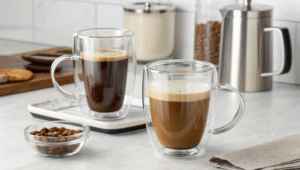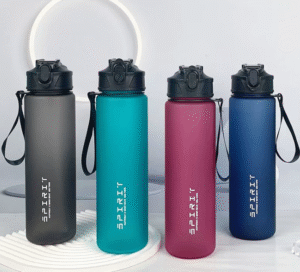You're sourcing a stainless steel thermos, but thousands of options look identical. Choosing poorly leads to bad reviews, unhappy customers, and a failed product line built on flimsy promises.
To choose a quality stainless steel thermos, prioritize the technical specifications: food-grade 304 (or 18/8) stainless steel, effective double-wall vacuum insulation, and a well-engineered, leak-proof lid. These factors determine performance, safety, and durability.
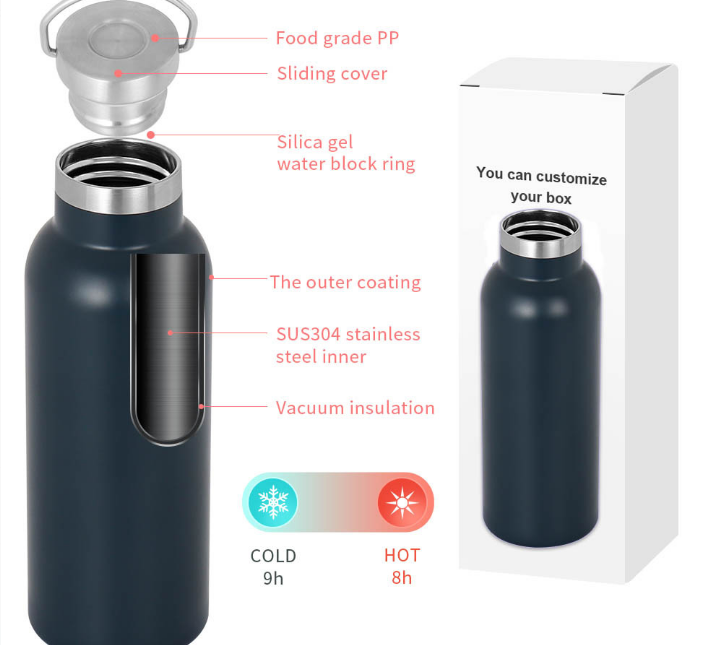
I remember talking with Emily, a product developer I know, who was frustrated. Her brand’s new tumbler was getting complaints about not keeping coffee hot. She had focused entirely on picking the perfect Pantone color for the coating. The factory she chose used a cheaper steel and a rushed vacuum-sealing process to cut costs. Her story is a perfect reminder for all of us in this industry: the true quality of a thermos is invisible. It’s not the color on the outside, but the materials and engineering on the inside that builds a brand's reputation.
What should you really look for in stainless steel cups?
The spec sheet from a supplier is full of technical jargon. It's hard to know which features are critical and which are just sales talk. You need to know the non-negotiables.
Focus on four core elements: the steel grade (18/8 or 304 is best), the insulation method (double-wall vacuum is essential), the lid's seal and usability, and verified food-grade safety certifications.
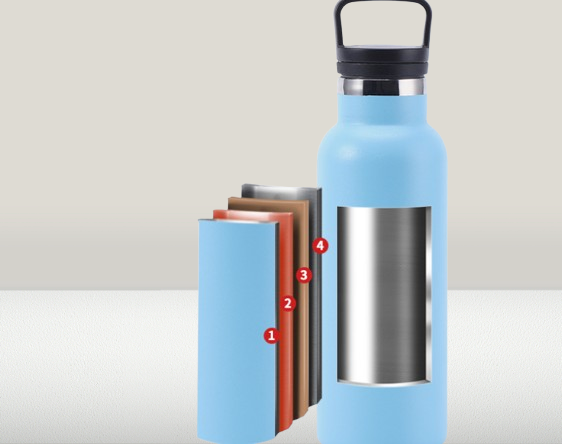
When I develop a new product line, I use a simple checklist that prioritizes function over form. Aesthetics are important for marketing, but they mean nothing if the product doesn't work. The real value is in the parts the customer can't see. Is the vacuum seal perfect? Is the lid mechanism durable enough for daily use? Is the steel grade guaranteed? Answering these questions is the foundation of creating a successful, long-lasting product. In my experience, a durable, high-performing cup in a simple color will always outsell a beautiful cup that fails.
Your Developer's Checklist for Core Features
Think of this as the anatomy of a great cup. Each part plays a critical role in the final performance.
- Material Grade: This is your number one priority. Insist on 304 stainless steel, also marketed as 18/8 stainless steel. This grade offers the best resistance to rust and corrosion and won't leave a metallic taste in the water. Avoid the cheaper 201 grade, as it's prone to rust.
- Insulation Technology: A cup is only a "thermos" if it has vacuum insulation. Look for a double-wall construction where the air between the two walls has been removed. This vacuum is what stops heat transfer and keeps drinks hot or cold for hours. A premium feature to look for is an additional copper lining on the inner wall, which further boosts insulation performance by reflecting thermal radiation.
- Lid Engineering: A great thermos can be ruined by a bad lid. Check for a high-quality, flexible silicone gasket that creates a leak-proof seal. Test the opening mechanism—whether it's a flip-top, straw lid, or screw-on—for durability and ease of cleaning. A complex lid with hidden parts is a breeding ground for mold.
- Safety and Compliance: Your product must be safe. Ensure all parts, especially the lid, are certified BPA-free. Depending on your target market, ask the supplier for documentation like FDA or LFGB compliance reports. This protects both your customer and your brand.
What makes a thermal cup truly "good"?
Your cup promises to keep drinks hot for 12 hours, but it's lukewarm in four. This performance gap is a huge letdown for customers and a direct blow to your brand's credibility.
A good thermal cup excels at one thing: minimizing heat transfer. This is achieved through a near-perfect vacuum between its double walls, an airtight lid seal, and minimal thermal bridging from the outside to the inside.

I once had to explain to a client why our proposed tumbler was more expensive than a competitor's identical-looking model. I skipped the sales pitch and broke out a diagram to explain basic physics. Heat moves in three ways: conduction (touch), convection (air movement), and radiation (heat waves). A good thermos is a fortress designed to fight all three. The client, a sharp product manager much like Emily, got it immediately. She understood she wasn't paying for steel, but for superior engineering. Framing the value this way helps justify the cost of quality.
The Science Behind a High-Performance Thermos
Understanding how a thermos works helps you ask suppliers the right questions. It's all about stopping heat from escaping (or entering).
| How Heat Transfers | How a "Good" Thermos Stops It | What to Look For |
|---|---|---|
| Conduction | The vacuum between the two stainless steel walls is an empty space, so there is almost no material for the heat to conduct (travel) through. | Ask the supplier about their vacuum-sealing process and quality control. A poor vacuum is the most common reason for failure. |
| Convection | The airtight lid with a silicone gasket stops air from circulating, preventing heat from being carried away from the surface of the liquid. | Look for lids with robust, well-fitted seals. Test the seal with water to ensure it's truly leak-proof. |
| Radiation | A thin copper plating on the outside of the inner wall reflects thermal radiation (infrared energy) back into the liquid, instead of letting it radiate out. | This is a premium feature. If a supplier offers a copper-lined version, it will almost always have superior insulation performance. |
A "good" thermal cup isn't magic; it's just very effective at blocking these three paths.
What is the best grade of stainless steel for cups?
You see codes like 304, 18/8, and 201 bandied about by suppliers. Using the wrong one can lead to rusty products, customer complaints, and potential safety liabilities for your brand.
The best and most widely accepted grade for drinkware is 304 stainless steel, also known as 18/8. It offers an excellent combination of corrosion resistance, durability, and proven food-grade safety, making it the industry standard.
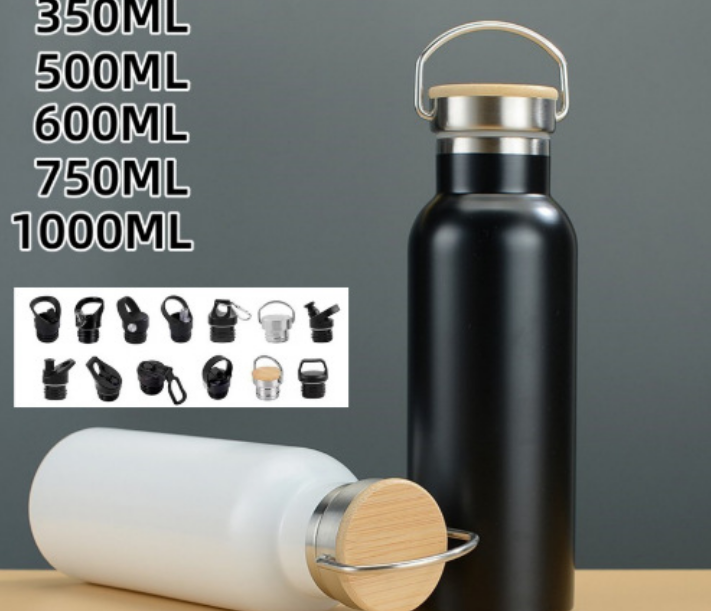
Early in my career, I got a "great deal" on a batch of unbranded tumblers for a promotional event. Within a few months, we started getting complaints about small rust spots appearing inside. I dug into the original order and realized the factory had used 201 stainless steel instead of 304 to meet my low price point. It was a costly lesson. Now, specifying 304 (18/8) steel is the first thing I do. It’s a non-negotiable point that protects the product's integrity and my brand's reputation.
Understanding Stainless Steel Grades
The grade of steel is determined by its chemical composition, which dictates its performance. For a product developer, knowing the difference is crucial.
| Grade | Composition Highlights | Key Characteristics | Best Use Case for Drinkware |
|---|---|---|---|
| 304 (18/8) Steel | ~18% Chromium, ~8% Nickel | The Gold Standard. Highly resistant to rust and corrosion, durable, no metallic taste, widely recognized as food-safe. | The required standard for almost all quality drinkware. It handles coffee, tea, juice, and water without any issues. |
| 201 Steel | Lower Nickel, Higher Manganese | The Cheaper Alternative. Less resistant to corrosion. Prone to rusting over time, especially with acidic liquids. | Avoid for insulated drinkware. It might be used for outer walls, but it should never be the inner wall that holds the beverage. |
| 316 (Marine Grade) Steel | 304 composition + Molybdenum | The Premium Choice. Superior corrosion resistance, especially against salts and acids. Used in medical implants. | Overkill for most uses, but a great marketing point for a premium product line focused on ultimate durability and chemical resistance. |
As a developer, your safest and most reliable choice is always 304/18/8 stainless steel. It delivers the quality and safety customers expect.
Are all stainless steel cups really the same?
Two tumblers can look identical on a sourcing website but have a 50% price difference. This makes it tempting to choose the cheaper option, but you suspect there's a hidden catch you can't see.
No, they are vastly different. The invisible differences—like the grade of steel (304 vs. 201), the quality and completeness of the vacuum, the engineering of the lid, and the durability of the outer coating—are what separate a premium product from a cheap one.
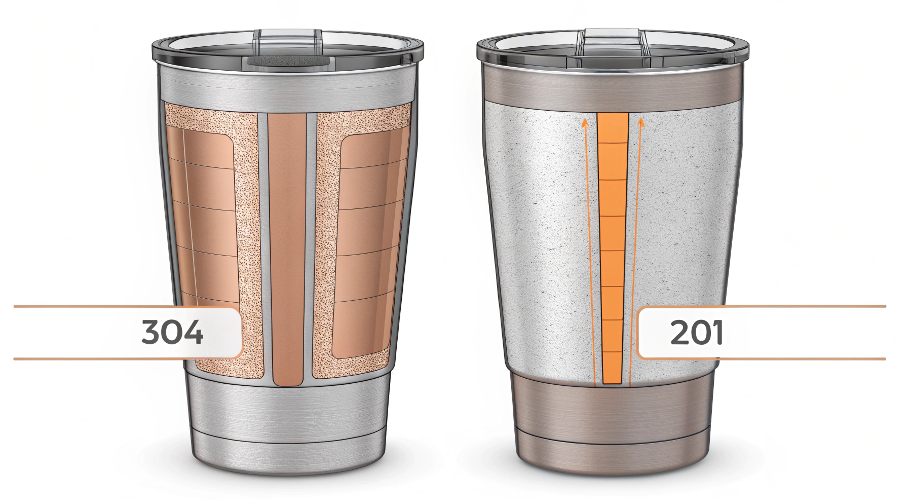
I always tell my partners, including developers like Emily, that when you buy a stainless steel tumbler, you're paying for the process as much as the material. A factory can save money by using cheaper steel, spending less time on the vacuum pump, or using a simple, leaky lid design. These shortcuts are invisible from the outside but become obvious once the customer uses the product. A reliable supplier invests in quality control at every step, and that investment is what you're really paying for. It's the price of a product that works as advertised.
The Developer's Product Inspection Checklist
Before placing a bulk order, use this checklist to question your supplier and evaluate samples. The answers will reveal the true quality of the product.
| Feature Area | What to Ask Your Supplier | What to Look for in a Sample |
|---|---|---|
| Inner Steel | "What grade of steel is the inner wall? Can you provide a material test report?" | The gold standard is 304 (18/8). Be very cautious of suppliers who won't specify the grade. |
| Insulation | "What is your vacuum testing process? What is the guaranteed insulation time?" | Perform a simple hot water test. Fill the cup with hot water, seal it, and feel the outside. If it gets warm, the vacuum has failed. |
| Lid Construction | "What material is the lid made from? Is it BPA-free? Can I see the silicone seal?" | The lid should feel solid, not flimsy. The seal should be thick and fit snugly. The mechanism should be easy to operate and clean. |
| Outer Coating | "What type of coating is this? Is it powder coating or spray paint?" | Powder coating is far more durable and resistant to chipping and scratching than simple spray paint. It often has a slightly textured feel. |
The difference between a $5 cup and a $10 cup lies in these details.
Conclusion
Choosing the right thermos is about substance, not style. By focusing on 304 steel, true vacuum insulation, and a reliable lid, you can develop a product that delivers real performance and builds lasting brand trust.

